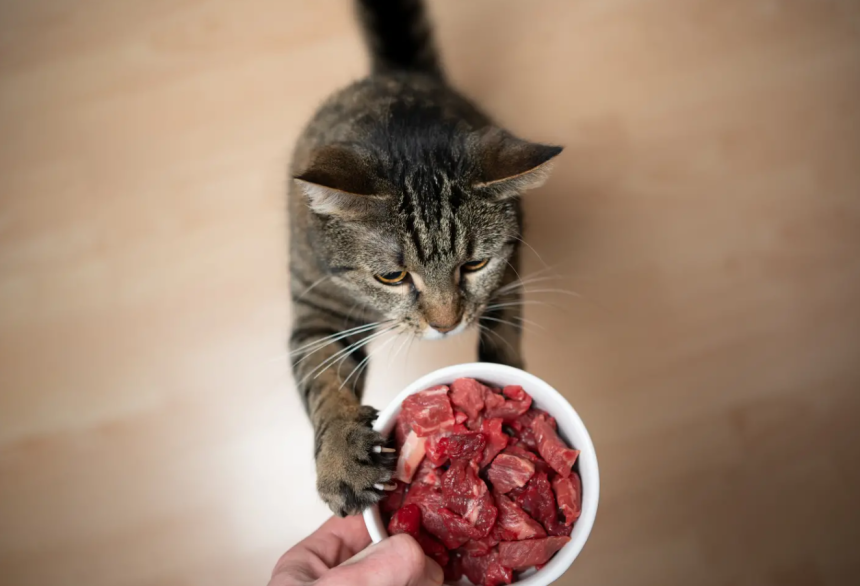The concept of raw cat food, though gaining popularity in recent years, remains a somewhat controversial topic among pet owners. We often find ourselves asking what’s best for our furry friends and whether commercial or raw food options offer the healthiest solution.
Raw Diet Fundamentals
Delving into the origins and nature of raw diets, we will take a step back to understand how it all started. The journey brings us closer to the essence of feline dietary habits in the wild and the foundational principles of the raw diet.
How It All Started
The story of the raw diet for cats begins with the cats themselves. Their wild ancestors, owing to the necessities of survival, consumed what nature provided – predominantly small animals. This diet consisted primarily of raw meat and bones, supplemented occasionally with the content of their prey’s stomach, introducing some plant matter. Today, feeding raw meat to cats is seen by many as a way to respect these innate dietary habits.
Wild Eating Habits Echoed
A raw diet for cats is designed to emulate the kind of food felines would naturally consume in the wild. The idea is to mirror the balance of meat, organs, and bones found in a typical small prey animal. This is a significant departure from the processed, commercial fare typically found in grocery stores and pet shops, which some believe doesn’t fully meet the needs of our carnivorous companions.
Benefits of Raw Food
Moving away from commercial pet food to healthy cat food or raw meat for cats offers some notable potential benefits.
- Improved Dental Health – Raw food can contribute to improved dental health since the act of gnawing on raw, meaty bones can help clean a feline’s teeth naturally.
- Enhanced Digestion and Shinier Coat – A raw diet may enhance digestion due to its lack of fillers and additives that can sometimes upset a cat’s stomach. Additionally, a raw diet often leads to a shinier coat, thanks to the healthy fats present in raw meat.
- Boosting Energy Levels – Lastly, some feline owners notice an increase in their cat’s energy levels when switching to a raw diet, potentially resulting from more natural and easily-digestible protein sources.
Balanced Raw Diets
Creating a balanced raw diet is a nuanced process, relying on the correct proportions of muscle meat, organs, bones, and supplements. Here, we will provide you with a detailed understanding of how to maintain balance in a raw diet, ensuring all nutritional bases are covered.
The Muscle Meat Component
In the wild, a large part of a cat’s diet consists of muscle meat. In a balanced raw diet, muscle meat should be the most significant component, making up about 80-85% of the total diet. This includes not just the lean meat but also some connective tissue and fat, providing a comprehensive range of amino acids, essential fatty acids, and other nutrients.
Organ Inclusion
Organs form an essential part of the raw diet for felines. They should make up about 10% of the diet and should include a variety of organs for nutritional completeness. Liver, kidney, and heart are common choices that offer a wide range of essential nutrients not found in muscle meat alone.
Bones in the Diet
Bones contribute about 5-10% of a raw diet, providing a source of calcium and phosphorus, crucial for bone health. They also help to maintain dental hygiene. When incorporating bones into a raw diet, it’s crucial to use raw bones small enough for your pet to chew safely, such as poultry bones.
Supplement Consideration
While a well-balanced raw diet can provide many of the necessary nutrients for cats, some essential elements are not adequately supplied by meat, organs, and bones alone. To compensate for these, certain supplements are needed, such as taurine, an essential amino acid for cats, and omega fatty acids, which support skin and coat health.
Starting the Raw Journey
Transitioning your feline friend to a raw diet is a journey that requires understanding and patience. This section is dedicated to offering you practical advice on how to initiate the transition, keeping in mind your cat’s individual preferences and safety considerations.
- Acknowledging Cat Preferences – Before transitioning to a raw diet, it’s crucial to understand that every feline is unique. Some may eagerly accept raw food, while others might need some coaxing. Remember, it’s vital to consider your pet’s preferences and gradually introduce the raw food to ensure a smooth transition.
- Gentle Transitioning – Switching to raw food is a gradual process. Start by replacing a small portion of your cat’s current diet with raw food, then gradually increase the raw portion over several weeks. This gradual change allows the feline’s digestive system to adjust, minimizing potential discomfort or upset.
- Ensuring Safe Food Handling – Food safety is an essential factor when feeding raw. Always source your raw meat and organs from reliable places to ensure freshness and quality. Additionally, maintain cleanliness and proper storage conditions to prevent bacterial contamination.
Vet Visits are Crucial
While you might see positive changes with a raw diet, regular veterinary consultations remain crucial. In this section, we’ll emphasize the importance of these check-ups in monitoring your pet’s health, ensuring nutritional balance, and addressing potential issues promptly.
Monitoring Your Feline’s Health
While raw diets can have many benefits, it’s essential to regularly consult with your vet to monitor your cat’s health. Regular check-ups can help identify any potential issues early and allow for diet adjustments as needed.
Nutritional Checks
Vet visits also provide an opportunity to ensure that the raw diet is nutritionally balanced. Your vet can perform tests to determine if your pet is getting the right balance of nutrients and recommend adjustments or supplements as necessary.
Transitioning to a raw diet is a considerable commitment that can potentially offer significant benefits for your cat. While a raw diet aims to mimic a feline’s natural dietary habits, remember that every cat is unique.
What works well for one might not work for another. Always approach the transition with patience and a focus on your cat’s health and happiness. And never forget – regular vet check-ups are essential to ensure that your chosen diet is truly the healthiest choice for your feline friend.















